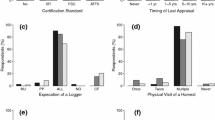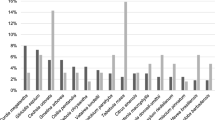Abstract
Conifer reforestation programs have traditionally been carried out using natural seeding, direct seeding or, more recently, planting with nursery-grown stock. Only within the past decade have rooted cuttings found use in large scale commercial operations. To assess the current status of this technology questionnaires were developed and mailed to 50 individuals and organizations around the world. The questionnaires were designed to collect information on: (1) annual production by region and species, (2) objectives of rooted cutting programs, (3) production procedures, (4) field performance of cuttings as compared to seedlings, and other topics.
According to the 36 responses received more than 65 million conifer rooted cuttings are being produced around the world annually, with this number growing rapidly. Fully half the production is in Japan where valuable sugi (Cryptomeria japonica D. Don) cultivars have been vegetatively propagated for at least five centuries. Another 10 million or more cuttings of radiata pine (Pinus radiata D. Don) are being grown in Australia and New Zealand annually. Canada, Scandinavia, and the British Isles together produce about 21 million Norway Spruce (Picea abies [L.] Karst), Sitka spruce (P. sitchensis [Bong.] Carr) black spruce (P. mariana [Mill.] B.S.P.) and other species annually. Programs of one million or less exist in France, West Germany, Belgium, Eastern Europe, the United States and the USSR.
Aside from the Japanese program and some European and Scandinavian programs, where cloning valuable genotypes is the main aim of vegetative propagation, the primary use of rooted cutting technology is for bulk production of genetically improved half or full-sib families. Other uses include production of air pollution-resistant clones in eastern Europe, and production of species which have high commercial value but are difficult to propagate from seed.
Propagation methods have changed little during the past 15 years. Most cuttings are produced from hedges, stock plants, nursery seedlings or field grown trees, and rooted under mist in glass or plastic covered houses. Rooting hormones are often, but not always, used. Roughly half are grown in containers and half bareroot, generally reflecting the preferred method of seedling production in a given region. Although relatively few detailed studies have been reported, field performance of rooted cuttings appears similar to that of seedlings provided donor plants are juvenile. Key research needs are juvenility maintenance, stock plant culture, root system improvement, mechanization, and field testing.
Similar content being viewed by others
References
Armson K. A., Fung M. and Bunting W. R. 1980. Operational rooting of black spruce cuttings. J. For. 78: 341–343.
Anon. 1982: Regulations on clonal forestry with Picea abies. Swedish National Board of Forestry. Statute Book SKSFS 1982: 1.
Arnold R. and Gleed J. 1985. Raising and managing radiata pine cuttings for production forests. Aust. For. 48: 199–206.
Bentzer, B. 1981. Large scale propagation of Norway spruce (Picea abies [L.] Karst.) by cuttings. In: Symp. on Clonal Forestry, Swedish Univ. of Agric. Sci., Dept. of Forest Genetics, Res. Note # 32 Uppsala, Sweden 33–42.
Bentzer, B. (in press). Strategies for clonal forestry with Norway spruce. In: Ahuja, M. R. and Libby, W. J. (Eds) Clonal Forestry: Genetics, Biotechnology and Application. Springer-Verlag, Berlin, New York.
Höhne I., Schmeckebier B. and Kopp S. 1988. Möglichkeiten zur Mechanisierung bei der autovegetativen Vermehrung von Nadelbaumarten, insbesondere der Gemeinen Fichte. Beiträge für die Fortwirtschaft 22: 30–33.
John A. and Mason W. L. 1987. Vegetative propagation of Sitka spruce. Proc. Roy. Soc. Edinburgh, 93B, 197–203.
Johnsen O. 1985. Successive bulk propagation of juvenile plants from full-sib families of Norway spruce. For. Ecol. Manage. 11: 271–282.
Karki L. and Tigerstedt P. M. A. 1985. Definition and exploration of forest tree ideotypes in Finland. In: Cannell M. G. R. and Jackson J. E. (Eds) Attributes of trees as crop plants. Inst. of Terrestrial Ecology, Scotland, 102–109.
Kleinschmit J. 1974. A programme for large-scale cutting propagation of Norway spruce. New Zeal. J. For. Sci. 4: 359–366.
Kleinschmit, J. 1985. Concepts and experiences in clonal plantations of conifers, pp. 26–56. In: Zsuffa, L., Rauter, R. M. and Yeatman, C. W. (Eds) Clonal Forestry: its impact on tree improvement and our future forests. Proc. 19th Meeting Canadian Tree Improvement Association, Toronto, August 22–26, 1983.
Lepisto M. 1974. Successful propagation by cuttings of Picea abies. New Zeal. J. For. Sci. 4: 367–370.
Libby W. J., Brown A. G. and Fielding J. M. 1972. Effects of hedging radiata pine on production, rooting, and early growth of cuttings. New Zeal. J. For. Sci. 2: 263–283.
Libby W. J. and Hood J. V. 1976. Juvenility in hedged radiata pine. Acta. Hort. 56: 91–98.
Menzies, M. I., Faulds, T., Dibley, M. and Aitken-Christie, J. 1985. Vegetative propagation of radiata pine in New Zealand. p. 167–190. In: South, D.B. (Ed) Proc. Int'l Symp. on Nursery Mgmt. Practices for the Southern Pines, Montgomery, AL, Aug. 4–9, 1985.
Menzies M. I., Aimers J. P. and Whitehouse L. J. (Eds), 1988. Workshop on growing radiata pine from cuttings, Rotorua, 5–7 May, 1986, Min. of For., For. Res. Inst., Rotorua, New Zealand. Bulletin 135, 197 p.
Ohba, K. 1985. Cryptomeria in Japan, pp. 145–162. In: Zsuffa, L., Rauter, R. M. and Yeatman, C. W. (Eds) Clonal Forestry: its impact on tree improvement and our future forests. Proc. 19th Meeting Canadian Tree Improvement Association, Toronto, Aug 22–26, 1983.
Ohba, K. (in press). Clonal forestry with sugi (Cryptomeria japonica). In: Ahuja, M. R. and Libby, W. J. (Eds) Clonal Forestry: Genetics, Biotechnology and Application. Springer Verlag, Berlin, New York.
Phillion B. J. 1982. Large-scale production of black spruce cuttings for progeny tests. Proc. Int. Plant Propagators Soc. 32: 619–625.
Ritchie G. A. and Long A. J. 1986. Field performance of micropropagated Douglas-fir. New Zeal. J. For. Sci. 16: 343–356.
Ritchie, G. A., Tanaka, Y. and Duke, S. D. (in press). Physiology and morphology of Douglas-fir rooted cuttings compared to seedlings and transplants. Tree Physiol.
Roulund H. 1974. Comparative study of characteristics of seedlings and clonal cuttings. New Zeal. J. For. Sci. 4: 378–386.
Spencer D. J. 1987. Increased yields of high quality veneer and sawn timber from cuttings of radiata pine. Aust. For. 50: 112–117.
St. Clair J. B. and Kleinschmit J. 1985. Juvenility and serial propagation of Norway spruce cultivars (Picea abies Karst.). Silv. Genet. 34: 42–48.
Toda R. 1974. Vegetative propagation in relation to Japanese forest tree improvement. New Zeal. J. For. Sci. 4: 410–417.
Vallée, J. 1990. Tree improvement and seedling production in Québec. Paper presented at Northeastern Nurserymen's Conference, Montréal, July 23–26, 1990 of the Northeastern State, Federal and Provincial Association, 13 pp.
Weiser F. and Schachler G. 1988. Aufbau sowie erste Ergebnisse zur Entwicklung und Nutzung eines stecklings-Mutterquartiers mit Fichtenklonen verminderter Anfälligkeit gegenüber SO2. Beiträge für die Forstwirtschaft 22: 55–61.
Author information
Authors and Affiliations
Rights and permissions
About this article
Cite this article
Ritchie, G.A. The commercial use of conifer rooted cuttings in forestry: a world overview. New Forest 5, 247–275 (1991). https://doi.org/10.1007/BF00028115
Received:
Accepted:
Issue Date:
DOI: https://doi.org/10.1007/BF00028115




